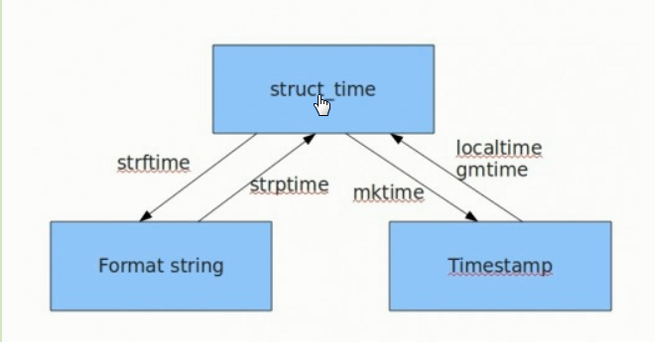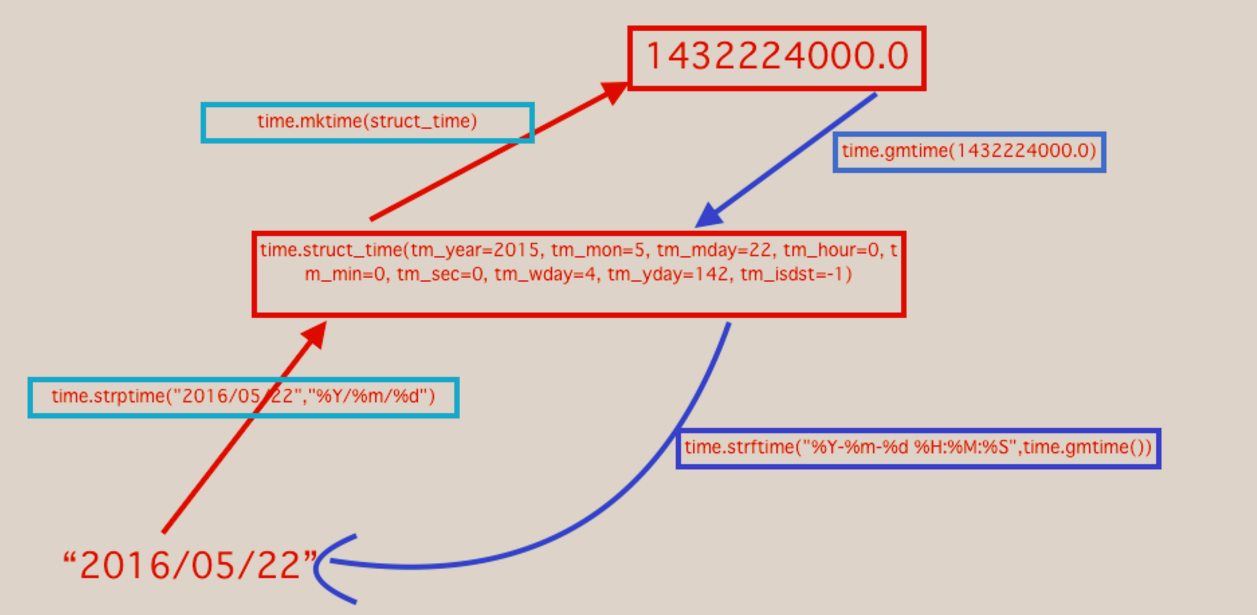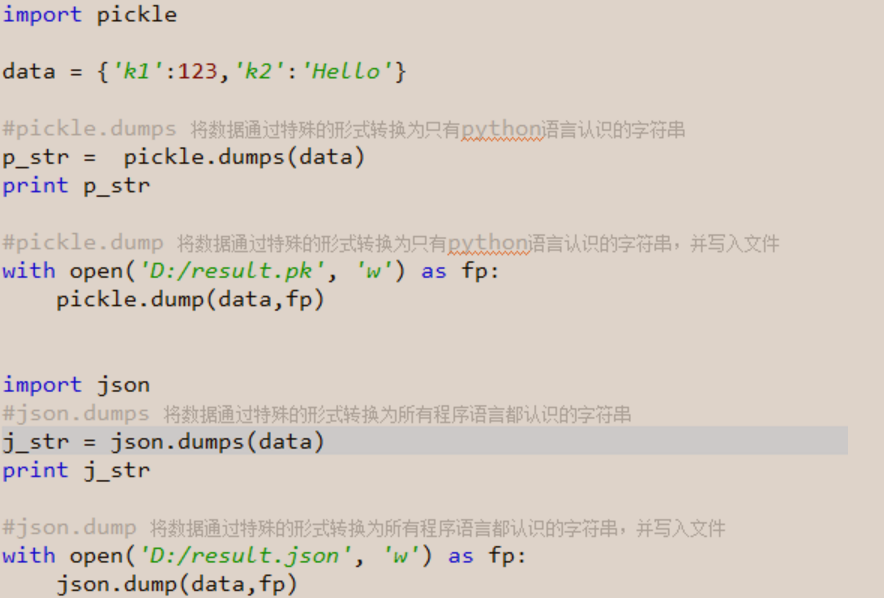Python基础-week05
一.模块介绍
模块,用一砣代码实现了某个功能的代码集合。
类似于函数式编程和面向过程编程,函数式编程则完成一个功能,其他代码用来调用即可,提供了代码的重用性和代码间的耦合。而对于一个复杂的功能来,可能需要多个函数才能完成(函数又可以在不同的.py文件中),n个 .py 文件组成的代码集合就称为模块。
1.定义
模块:用来从逻辑上组织python代码(变量,函数,类,逻辑),本质就是.py结尾的python文件名,用途就是实现一个功能。
例如:文件名为test.py,对应的模块就是test
2.导入方法
import module_name1
import module_name2,module_name3 #导入多个模块
from moudule_name import * #导入module_name中的所有函数和变量,可能会跟本地的函数重名。
from module_name import logger() as logger2 #与本地的logger()函数重名,进行重命名!
from和import的区别?
from调用函数可以直接使用,不用加模块名.xx 来调用。
import 调用需要用模块名.xxx来调用。
3.import本质(路径搜索和搜索路径)
导入模块的本质就是把python文件解释一遍:import moudule_alex
(相当于module_alex=all_code 把所有的代码)
import module_name --->module_name.py ---->module_name.py的路径----》sys.path
from test import m1 相当于m1='code'就可以直接使用和读取m1的值!
4.导入优化
#优化前!
import module_test
#导入优化后为,相当于把module_test的sayhello()函数拿到当前的文件中,不需要一遍遍的查找解释!
from module_test import sayhello
#也可以加上 as 起个别名防止跟当前文件中的函数名冲突!
5.模块的分类
a:标准库:sys,os 等
time和datetime
strftime('格式',struct_time)---->'格式化的字符串'
strptime('格式化的字符串','格式')--->struct_time(时间元祖)
b:开源模块(第三方模块)
yum install gcc等这类开源模块,也可以wget 下载源码包手动安装。
c.自定义模块
自己定义的python模块,提供给其他的py文件使用。
更详细的模块说明请参考武老师:http://www.cnblogs.com/wupeiqi/articles/4963027.html
6.模块的表现形式
1 使用python编写的.py文件
2 已被编译为共享库或DLL的C或C++扩展
3 把一系列模块组织到一起的文件夹(注:文件夹下有一个__init__.py文件,该文件夹称之为包)
4 使用C编写并链接到python解释器的内置模块
二.time & datetime 模块
1.time & datetime 方法实例
import time #1.时间戳,通过gmtime转换成元祖
x=time.time() #这个取出来的时间为分界点的时间,如果是中国要+8小时东八区,locatime可以直接取时间。
gmt=time.gmtime(x) #x不写默认为localtime本地时间
print (gmt.tm_year,'年',gmt.tm_mon,'月',gmt.tm_mday,'日') #2.格式化的时间字符串,gmt是将秒转换成元祖的格式。
#元祖转换成字符串
strtime=time.strftime("%Y-%m-%d %H:%M:%S",gmt)
strtime2=time.strftime("%Y-%m-%d %H:%M:%S",time.localtime())
print (strtime)
print (strtime2) #字符串转换成元祖,与strftime正好相反,格式可以随意排版,但是要与%H等参数对应。
print(time.strptime("2018-03-28 02:14:15","%Y-%m-%d %H:%M:%S"))
print(time.strptime("02:14:15 2018-03-12","%H:%M:%S %Y-%m-%d"))
sruct_time1=time.strptime("02:14:15 2018-03-12","%H:%M:%S %Y-%m-%d") #将元祖转换成字符串,如果不传参默认当前时间
print (time.asctime(sruct_time1))
print (time.asctime())
#(Wed Mar 28 17:48:04 2018) #,如果不传参默认当前时间
print (time.ctime())
#(Wed Mar 28 17:48:04 2018) #3.元祖,共九个元素
print(time.localtime()) #相当于 x=time.time() gmt=time.gmtime(x) #将秒转换成元祖,并取出其中指定的天
lt=time.localtime(123213123)
print ("in 1973 year's %d day!" %lt.tm_yday ) #将元祖转换成秒
print(time.mktime(lt))
time实例
#Author:http://www.cnblogs.com/Jame-mei
import datetime
#1.取当前时间
print (datetime.datetime.now()) #2.当前时间+3天
print (datetime.datetime.now()+datetime.timedelta(3)) #3.当前时间 -3天
print (datetime.datetime.now()+datetime.timedelta(-3)) #4.当前时间 +3小时
print (datetime.datetime.now()+datetime.timedelta(hours=3)) #4.当前时间 -30分钟
print (datetime.datetime.now()+datetime.timedelta(minutes=-30))
datetime实例
2.time & datetime图,练习完实例后多思考以下图




三.random模块
1.random常用方法实例
#Author:http://www.cnblogs.com/Jame-mei
import random '''random的实际应用:''' #1.随机整数,randint 包括5
print (random.randint(1,5)) #2.随机选取0-100的偶数,不包括101
print (random.randrange(0,101,2)) #3.随机浮点数1个,uniform范围不包括2;random(),默认1以内的
print (random.random())
print(random.uniform(1,2)) #4.随机字符串
print (random.choice('abcd'))
#从多个字符串中选取 多个字符串
print (random.sample(['abc','jame','tomcat'],2)) #5.洗牌
item=[1,2,3,4,5]
print ('before:',item)
random.shuffle(item)
print ('after:',item)
random常用实例
2.random的随机数应用
#Author:http://www.cnblogs.com/Jame-mei
import random
import string #打印4位数字(字母+数字随意)的验证码
checkcode=''
for i in range(5):
current=random.randrange(0,5)
#字母
if current==i:
tmp=chr(random.randint(65,90)) #chr将数字转换成ASCII码对应的字母!!
#数字
else:
tmp=random.randint(0,9) checkcode+=str(tmp) print (checkcode)
随机数
四.os模块(系统常用)
1.os模块常用方法练习
#Author:http://www.cnblogs.com/Jame-mei
import os
import time #1.getcwd(),获取该脚本的目录
#os.chdir("E:\pythonwork\s14\os")
print (os.getcwd()) #2.chdir,相当于cd,再os.getcwd()来获取当前的目录才能看出效果
os.chdir("E:\pythonwork\s14")
print (os.getcwd()) #3.curdir
print (os.curdir) #4.pardir 获取当前目录父目录的字符串名:..
print (os.pardir) #5.mkdirs,可生成多个递归目录,在当前目录下新建了os/test1/test2目录
#os.makedirs('os/test1/test2') #6.removedir,要求目录不为空的情况下
#os.removedirs(r"E:\pythonwork\s14\day05\os\os_test") #7.创建和删除目录
#os.mkdir(r"E:\pythonwork\s14\day05\os\test_os2")
#生成单级目录;相当于shell中mkdir dirname #os.rmdir(r"E:\pythonwork\s14\day05\os\test_os2")
#删除单级空目录,若目录不为空则无法删除,报错;相当于shell中rmdir dirname #8.listdir 列出指定目录下的所有文件和子目录,包括隐藏文件,并以列表方式打印
print(os.listdir('E:\pythonwork\s14\os')) #9.删除一个文件
#os.remove(r'E:\pythonwork\s14\day05\os\remove_test.py') #10.rename('oldname','newname') 重命名文件或者目录,其中windows里面的路径要加r,或者\来进行转义!
#os.rename(r'E:\pythonwork\s14\day05\os\rename_test.py',r'E:\pythonwork\s14\day05\os\rename_test2.py') #11.stat(path/filename) 获取文件、目录信息
print (os.stat(r'E:\pythonwork\s14\day05\os\test1.py')) #12.sep 输出操作系统特定的路径分隔符,可以进行跨平台,换个linux就变了/了
print (os.sep)
#.linsep 输出当前平安体使用的行终止符
print (os.linesep)
#.pathsep 输出用于分割文件路径的字符串
print(os.pathsep) #13.name 输出字符串指示当前使用平台
print (os.name) #14.system()运行shell命令,直接显示
print (os.system("ls -l")) #15.environ 获取系统环境变量
print (os.environ) #16.os.path大类! #os.path.abspath() 返回path规范化的绝对路径,
print (os.path.abspath('test1.py')) #os.path.split(path) 将path分割成目录和文件名二元组返回
print (os.path.split('E:\pythonwork\s14\day05\os\test1.py'))
#output:('E:\\pythonwork\\s14\\day05', 'os\test1.py') 这样一个元祖。 #返回path的目录。其实就是os.path.split(path)的第一个元素
print (os.path.dirname('E:\pythonwork\s14\day05\os\test1.py')) # os.path.basename(path) 返回path最后的文件名。如何path以/或\结尾,那么就会返回空值。即os.path.split(path)的第二个元素
print (os.path.basename('E:\pythonwork\s14\day05\os\test1.py')) # os.path.exists(path) 如果path存在,返回True;如果path不存在,返回False
print (os.path.exists(r'E:\pythonwork\s14\day05\os\test1.py')) # os.path.isabs(path) 如果path是绝对路径,返回True
print (os.path.exists(r'E:\pythonwork\s14\day05\os\test1.py')) # os.path.isfile(path) 如果path是一个存在的文件,返回True。否则返回False
print (os.path.isfile(r'E:\pythonwork\s14\day05\os\test1.py')) # os.path.isdir(path) 如果path是一个存在的目录,则返回True。否则返回False
print (os.path.isdir(r'E:\pythonwork\s14\day05\os')) # os.path.join(path1[, path2[, ...]]) 将多个路径组合后返回,第一个绝对路径之前的参数将被忽略
print (os.path.join(r'E:\pythonwork\s14',r'day05',r'os',r'test1.py'))
#output:E:\pythonwork\s14\day05\os\test1.py # os.path.getatime(path) 返回path所指向的文件或者目录的最后存取时间
filetime=os.path.getatime(r"E:\pythonwork\s14\day05\os\rename_test2.py") #返回的秒数
print (time.strftime("%Y-%m-%d %H:%M:%S",time.localtime(filetime))) #先转换成元祖,再转换成指定格式的时间。 # os.path.getmtime(path) 返回path所指向的文件或者目录的最后修改时间
motime=os.path.getmtime(r"E:\pythonwork\s14\day05\os\rename_test2.py")
print (time.strftime("%Y-%m-%d %H:%M:%S",time.localtime(motime)))
os模块常用的方法练习
2.更多参考官方文档
https://docs.python.org/2/library/os.html?highlight=os#module-os
五.sys模块(系统常用)
1.sys模块常用方法练习
#1.argv 命令行参数List,第一个元素是程序本身路径
print (sys.argv)
#output:['E:/pythonwork/s14/day05/sys/sys_test1.py'] #2.exit(n)
#sys.exit(0) #3.version
print (sys.version)
#output: 3.6.3 (v3.6.3:2c5fed8, Oct 3 2017, 18:11:49) [MSC v.1900 64 bit (AMD64)] #4.maxint,python3已经找不到该方法了 #5.path
print (sys.path) #6.sys.platform,输出的是win32的操作系统的信息
print (sys.platform) #7.stdout,标准输出
sys.stdout.write('please:')
val = sys.stdin.readline()[:-1]
print (val)
sys常见方法
2.更多参考官方文档
https://docs.python.org/2/library/sys.html?highlight=sys#module-sys
六.shutil模块
高级的 文件、文件夹、压缩包 处理模块。
1.拷贝(src为源文件,dst为目标文件)
shutil.copy(src, dst)
拷贝文件和权限
shutil.copy2(src, dst)
拷贝文件和状态信息
shutil.copyfile(src, dst)
拷贝文件
shutil.copyfileobj(fsrc, fdst[, length])
将文件内容拷贝到另一个文件中,可以部分内容
f1=open("本节笔记",encoding='utf-8')
f2=open("笔记2",'w',encoding='utf-8')
#shutil.copyfileobj(f1,f2)
copyfileobj(file1,file2)
shutil.copymode(src, dst)
仅拷贝权限。内容、组、用户均不变
shutil.copystat(src, dst)
拷贝状态的信息,包括:mode bits, atime, mtime, flags
shutil.ignore_patterns(*patterns)
shutil.copytree(src, dst, symlinks=False, ignore=None)
递归的去拷贝文件(常用)
递归的去拷贝文件,这个常用!
#shutil.copytree(r"E:/pythonwork/s14/day05/shutil",r"E:/pythonwork/s14/day05/shutil/newshutil")
copytree常用
2.删除
shutil.rmtree(path[, ignore_errors[, onerror]])
递归的去删除文件(常用)
#递归的去删除文件
#shutil.rmtree(r"E:/pythonwork/s14/day05/shutil/newshutil")
rmtree对删除,常用
3.移动
shutil.move(src, dst)
递归的去移动文件
4.压缩和解压
shutil.make_archive(base_name, format,...)
创建压缩包并返回文件路径,例如:zip、tar
- base_name: 压缩包的文件名,也可以是压缩包的路径。只是文件名时,则保存至当前目录,否则保存至指定路径,
如:www =>保存至当前路径
如:/Users/wupeiqi/www =>保存至/Users/wupeiqi/ - format: 压缩包种类,“zip”, “tar”, “bztar”,“gztar”
- root_dir: 要压缩的文件夹路径(默认当前目录)
- owner: 用户,默认当前用户
- group: 组,默认当前组
- logger: 用于记录日志,通常是logging.Logger对象
实例:shutil.make_archive():
#创建压缩包并返回文件路径,例如:zip、tar,会把shutil目录下的所有压缩备份到当前目录的backup_py.zip,最好压缩到其他地方避免死循环。
ret = shutil.make_archive(r"D:\pytest\backup_py", 'zip', root_dir='E:/pythonwork/s14/day05/shutil')
make_archive(base_name,format...)
4.1.zipfile 压缩解压
#Author:http://www.cnblogs.com/Jame-mei
import zipfile # 压缩
z = zipfile.ZipFile('ziptest.zip', 'w')
z.write('test1.py') #将要压缩的文件写入!!
z.write('本节笔记')
z.close() # 解压
z = zipfile.ZipFile('ziptest.zip', 'r')
z.extractall(path="ziptest") #将ziptest.zip解压到当前文件夹下,娶一个名字叫ziptest
z.close()
zipfile压缩解压
4.2.tarfile压缩解压
#Author:http://www.cnblogs.com/Jame-mei
import tarfile #1.压缩
tf=tarfile.open('tarfile.tar','w')
tf.add(r'E:/pythonwork/s14/day05/shutil/ziptest.zip','ziptest.zip')
tf.close() #2.解压
zf=tarfile.open('tarfile.tar','r')
zf.extractall(r"E:/pythonwork/s14/day05/shutil/tarfile") #解压成这个目录下,名字叫tarfile的文件夹!
zf.close()
tarfile.open(name,model=r/w)
七.json & pickle(文件保存及网络传输常用)
用于序列化的两个模块
- json,用于字符串 和 python数据类型间进行转换,解决了不通语言之间的通信例如java/php等。
- pickle,用于python特有的类型 和 python的数据类型间进行转换,解决了python语言内部的通信。
Json模块提供了四个功能:dumps、dump、loads、load
pickle模块提供了四个功能:dumps、dump、loads、load

更多详情见:python基础-week04的json&pickle章节内容!
八.shelve
shelve模块是一个简单的k,v将内存数据通过文件持久化的模块,可以持久化任何pickle可支持的python数据格式。
shelve存入读取实例:
#Author:http://www.cnblogs.com/Jame-mei
import shelve
import datetime d = shelve.open('shelve_test') # 打开一个文件
t=datetime.datetime.now() # class Test(object):
# def __init__(self, n):
# self.n = n info={'age':24,'job':'it'}
name = ["alex", "rain", "test"] #1.写入
d["names"] = name # 持久化列表
d["dicts"] =info # 持久化字典
d['tz']=t #持久化时间类型 #2.读出来
print(d.get('names'))
print(d.get('dicts'))
print (d.get('tz'))
shelve.open(...)
九.xml处理(1-2)
1.xml简介和格式
xml是实现不同语言或程序之间进行数据交换的协议,跟json差不多,但json使用起来更简单,不过,古时候,在json还没诞生的黑暗年代,大家只能选择用xml呀,至今很多传统公司如金融行业的很多系统的接口还主要是xml。
xml的格式如下,就是通过<>节点来区别数据结构的:
<?xml version="1.0"?>
<data>
<country name="Liechtenstein">
<rank updated="yes">2</rank>
<year>2008</year>
<gdppc>141100</gdppc>
<neighbor name="Austria" direction="E"/>
<neighbor name="Switzerland" direction="W"/>
</country>
<country name="Singapore">
<rank updated="yes">5</rank>
<year>2011</year>
<gdppc>59900</gdppc>
<neighbor name="Malaysia" direction="N"/>
</country>
<country name="Panama">
<rank updated="yes">69</rank>
<year>2011</year>
<gdppc>13600</gdppc>
<neighbor name="Costa Rica" direction="W"/>
<neighbor name="Colombia" direction="E"/>
</country>
</data>
xml格式范文:
xml协议在各个语言里的都 是支持的,在python中可以用以下模块操作xml :
1.遍历xml的内容和子节点标签
#Author:http://www.cnblogs.com/Jame-mei
import xml.etree.ElementTree as xeet tree=xeet.parse('test_xml.xml')
root=tree.getroot() print (root)
print (root.tag,root.text) #1.遍历xml文件 ,tag标签,attrib属性,text标签的值
for child in root:
print (child.tag,child.attrib)
for i in child:
print (i.tag,i.attrib,i.text)
print("=============================================================>>>") #2.只遍历 rank子节点标签的属性和内容
#只遍历year 节点
for node in root.iter('rank'):
print(node.tag,node.text,node.attrib)
遍历xml
2.删除、修改xml
#Author:http://www.cnblogs.com/Jame-mei
import xml.etree.ElementTree as xee
tree=xee.parse("test_xml.xml")
root=tree.getroot()
1.批量修改 rank标签中的值
for node in root.iter('rank'):
new_rank=int(node.text)+10
node.text=str(new_rank)
node.set('update','yes')
tree.write('test_xml.xml')
#2.删除
for country in root.findall('country'):
rank=int(country.find('rank').text)
if rank>50:
root.remove(country)
tree.write('output.xml') #将删除后的文本保存到output.xml中,这样可以保证源文件不会误操作无法恢复的情况。
3.自己创建生成一个xml文件
#Author:http://www.cnblogs.com/Jame-mei
import xml.etree.ElementTree as ET new_xml = ET.Element("namelist") name = ET.SubElement(new_xml, "name", attrib={"enrolled": "yes"})
age = ET.SubElement(name, "age", attrib={"checked": "no"})
age.text = '33'
sex = ET.SubElement(name, "sex")
sex.text="男" name2 = ET.SubElement(new_xml, "name", attrib={"enrolled": "no"})
age = ET.SubElement(name2, "age")
age.text = '19' et = ET.ElementTree(new_xml) # 生成文档对象
et.write("test.xml", encoding="utf-8", xml_declaration=True) ET.dump(new_xml) # 打印生成的格式 输出: <?xml version='1.0' encoding='utf-8'?>
<namelist>
<name enrolled="yes">
<age checked="no">33</age>
<sex>男</sex>
</name>
<name enrolled="no">
<age>19</age>
</name>
</namelist>
创建xml文件
十.yaml处理
Python也可以很容易的处理ymal文档格式,只不过需要安装一个模块,参考文档:http://pyyaml.org/wiki/PyYAMLDocumentation
开源的Ansible,Saltstack的配置文件都是用yaml写的。
十一.configparser
用于生成和修改常见配置文档,当前模块的名称在 python 3.x 版本中变更为 configparser。
来看一个好多软件的常见文档格式如下:
[DEFAULT]
ServerAliveInterval = 45 Compression = yes CompressionLevel = 9 ForwardX11 = yes [bitbucket.org] User = hg [topsecret.server.com] Port = 50022 ForwardX11 = no#Author http://www.cnblogs.com/Jame-mei
import configparser #python2.x ConfigParser 大写 config = configparser.ConfigParser() config["DEFAULT"] = {'ServerAliveInterval': '',
'Compression': 'yes',
'CompressionLevel': ''}
config['DEFAULT']['ForwardX11'] = 'yes' config['bitbucket.org'] = {}
config['bitbucket.org']['User'] = 'hg' config['topsecret.server.com'] = {}
topsecret = config['topsecret.server.com']
topsecret['Host Port'] = '' # mutates the parser
topsecret['ForwardX11'] = 'no' #same here #最后写入!
with open('example.ini', 'w') as configfile:
config.write(configfile) ================================================================================
输出如下:
[DEFAULT]
serveraliveinterval = 45
compression = yes
compressionlevel = 9
forwardx11 = yes [bitbucket.org]
user = hg [topsecret.server.com]
host port = 50022
forwardx11 = no
configparser生成配置文件
#2.读出
[DEFAULT]
serveraliveinterval = 45
compression = yes
compressionlevel = 9
forwardx11 = yes [bitbucket.org]
user = hg [topsecret.server.com]
host port = 50022
forwardx11 = no
配置源文件
#Author http://www.cnblogs.com/Jame-mei
import configparser config=configparser.ConfigParser() config.read('example.ini')
print(config.sections()) #打印出除了默认标签,以外的标签!!
print(config.defaults())
'''
输出:
['bitbucket.org', 'topsecret.server.com']
OrderedDict([('serveraliveinterval', '45'), ('compression', 'yes'), ('compressionlevel', '9'), ('forwardx11', 'yes')])
''' print (config['bitbucket.org']['User'])
print (config['DEFAULT']['Compression'])
'''
输出:
hg
yes ''' topsecret = config['topsecret.server.com']
print (topsecret['ForwardX11'])
print (topsecret['host port'])
'''
输出:
no
50022
''' print ('遍历configparaser-default默认标签的属性名==============================>>>>>>>>>>>>>>>>>>>>>>')
for key in config['DEFAULT']:
print(key)
'''
输出:
serveraliveinterval
compression
compressionlevel
forwardx11
''' print('遍历configparaser----bitbucket.org标签的属性名+default默认属性名==============================>>>>>>>>>>>>>>>>>>>>>>')
for key in config['bitbucket.org']:
print (key)
'''
遍历:
user
serveraliveinterval
compression
compressionlevel
forwardx11
''' print('遍历configparaser----topsecret.server.com标签的属性名+default默认属性名==============================>>>>>>>>>>>>>>>>>>>>>>')
for key in config['topsecret.server.com']:
print (key)
'''
输出:
host port
forwardx11
serveraliveinterval
compression
compressionlevel ''' #总结,遍历default就是只遍历default默认属性的名
# 遍历其他标签的属性名,也会遍历出default的属性名!
读取配置源文件的代码!
#3.configparser增删改查语法
[section1]
k1 = v1
k2:v2 [section2]
k1 = v1 import ConfigParser config = ConfigParser.ConfigParser()
config.read('i.cfg') # ########## 读 ##########
#secs = config.sections()
#print secs
#options = config.options('group2')
#print options #item_list = config.items('group2')
#print item_list #val = config.get('group1','key')
#val = config.getint('group1','key') # ########## 改写 ##########
#sec = config.remove_section('group1')
#config.write(open('i.cfg', "w")) #sec = config.has_section('wupeiqi')
#sec = config.add_section('wupeiqi')
#config.write(open('i.cfg', "w")) #config.set('group2','k1',11111)
#config.write(open('i.cfg', "w")) #config.remove_option('group2','age')
#config.write(open('i.cfg', "w"))
增删改查请多练习
十二.hashlib(加密常用)
用于加密相关的操作,3.x里代替了md5模块和sha模块,主要提供 SHA1, SHA224, SHA256, SHA384, SHA512 ,MD5 算法:
import hashlib m = hashlib.md5()
m.update(b"Hello")
m.update(b"It's me")
print(m.digest())
m.update(b"It's been a long time since last time we ...") print(m.digest()) #2进制格式hash
print(len(m.hexdigest())) #16进制格式hash
'''
def digest(self, *args, **kwargs): # real signature unknown
""" Return the digest value as a string of binary data. """
pass def hexdigest(self, *args, **kwargs): # real signature unknown
""" Return the digest value as a string of hexadecimal digits. """
pass '''
import hashlib # ######## md5 ######## hash = hashlib.md5()
hash.update('admin')
print(hash.hexdigest()) # ######## sha1 ######## hash = hashlib.sha1()
hash.update('admin')
print(hash.hexdigest()) # ######## sha256 ######## hash = hashlib.sha256()
hash.update('admin')
print(hash.hexdigest()) # ######## sha384 ######## hash = hashlib.sha384()
hash.update('admin')
print(hash.hexdigest()) # ######## sha512 ######## hash = hashlib.sha512()
hash.update('admin')
print(hash.hexdigest())
加密练习
还不够吊?python 还有一个 hmac 模块,它内部对我们创建 key 和 内容 再进行处理然后再加密散列消息鉴别码,简称HMAC,是一种基于消息鉴别码MAC(Message Authentication Code)的鉴别机制。使用HMAC时,消息通讯的双方,通过验证消息中加入的鉴别密钥K来鉴别消息的真伪;
一般用于网络通信中消息加密,前提是双方先要约定好key,就像接头暗号一样,然后消息发送把用key把消息加密,接收方用key + 消息明文再加密,拿加密后的值 跟 发送者的相对比是否相等,这样就能验证消息的真实性,及发送者的合法性了。
#Author http://www.cnblogs.com/Jame-mei
import hmac h=hmac.new('天王盖地虎'.encode(encoding='utf-8'),'小鸡炖蘑菇'.encode(encoding='utf-8')) print (h.digest())
print (h.hexdigest())
hmac
更多关于md5,sha1,sha256等介绍的文章看这里https://www.tbs-certificates.co.uk/FAQ/en/sha256.html
十三.subprocess
import subprocess '''
sh-3.2# ls /Users/egon/Desktop |grep txt$
mysql.txt
tt.txt
事物.txt
''' res1=subprocess.Popen('ls /Users/jieli/Desktop',shell=True,stdout=subprocess.PIPE)
res=subprocess.Popen('grep txt$',shell=True,stdin=res1.stdout,
stdout=subprocess.PIPE) print(res.stdout.read().decode('utf-8')) #等同于上面,但是上面的优势在于,一个数据流可以和另外一个数据流交互,可以通过爬虫得到结果然后交给grep
res1=subprocess.Popen('ls /Users/jieli/Desktop |grep txt$',shell=True,stdout=subprocess.PIPE)
print(res1.stdout.read().decode('utf-8')) #windows下:
# dir | findstr 'test*'
# dir | findstr 'txt$'
import subprocess
res1=subprocess.Popen(r'dir C:\Users\Administrator\PycharmProjects\test\函数备课',shell=True,stdout=subprocess.PIPE)
res=subprocess.Popen('findstr test*',shell=True,stdin=res1.stdout,
stdout=subprocess.PIPE) print(res.stdout.read().decode('gbk')) #subprocess使用当前系统默认编码,得到结果为bytes类型,在windows下需要用gbk解码
subprocess练习
十四.logging模块(常用)
很多程序都有记录日志的需求,并且日志中包含的信息即有正常的程序访问日志,还可能有错误、警告等信息输出,python的logging模块提供了标准的日志接口,你可以通过它存储各种格式的日志,logging的日志可以分为 debug(), info(), warning(), error() and critical() 5个级别,下面我们看一下怎么用。
最简单用法:
|
1
2
3
4
5
6
7
8
|
import logginglogging.warning("user [alex] attempted wrong password more than 3 times")logging.critical("server is down")#输出WARNING:root:user [alex] attempted wrong password more than 3 timesCRITICAL:root:server is down |
待续....
十五.re正则(对于爬虫重要)
常用正则表达式:
'.' 默认匹配除\n之外的任意一个字符,若指定flag DOTALL,则匹配任意字符,包括换行
'^' 匹配字符开头,若指定flags MULTILINE,这种也可以匹配上(r"^a","\nabc\neee",flags=re.MULTILINE)
'$' 匹配字符结尾,或e.search("foo$","bfoo\nsdfsf",flags=re.MULTILINE).group()也可以
'*' 匹配*号前的字符0次或多次,re.findall("ab*","cabb3abcbbac") 结果为['abb', 'ab', 'a']
'+' 匹配前一个字符1次或多次,re.findall("ab+","ab+cd+abb+bba") 结果['ab', 'abb']
'?' 匹配前一个字符1次或0次
'{m}' 匹配前一个字符m次
'{n,m}' 匹配前一个字符n到m次,re.findall("ab{1,3}","abb abc abbcbbb") 结果'abb', 'ab', 'abb']
'|' 匹配|左或|右的字符,re.search("abc|ABC","ABCBabcCD").group() 结果'ABC'
'(...)' 分组匹配,re.search("(abc){2}a(123|456)c", "abcabca456c").group() 结果 abcabca456c '\A' 只从字符开头匹配,re.search("\Aabc","alexabc") 是匹配不到的
'\Z' 匹配字符结尾,同$
'\d' 匹配数字0-9
'\D' 匹配非数字
'\w' 匹配[A-Za-z0-9]
'\W' 匹配非[A-Za-z0-9]
's' 匹配空白字符、\t、\n、\r , re.search("\s+","ab\tc1\n3").group() 结果 '\t' '(?P<name>...)' 分组匹配 re.search("(?P<province>[0-9]{4})(?P<city>[0-9]{2})(?P<birthday>[0-9]{4})","371481199306143242").groupdict("city") 结果{'province': '3714', 'city': '81', 'birthday': '1993'}
常用
#Author http://www.cnblogs.com/Jame-mei
import re #match .+以任意多个字符开头,\d数字结尾
res1=re.match("^.+\d", "cai123yuanhua")
print (res1.group())
#cai123 #rearch {3}每次只匹配最多3个数字
res2=re.search("[0-9]{3}","aa123x2a34567aa")
print (res2.group())
# re4=re.search("ABC|abc","abcABCCD").group()
print (re4)
#'abc',先匹配ABC没有,又开始匹配abc res6=re.search("(abc){2}","alexabcabcabcbad")
print (res6.group())
#abcabc res7=re.search("(abc){2}a(123|456)c", "abcabca456c").group()
print ('res7:',res7)
#res7: abcabca456c res8=re.search(".*\D","alexabcabcabcbad.,&").group()
print (res8)
#alexabcabcabcbad.,& ,匹配非数字的所有 res9=re.search("\D+","alexabcabcabcbad.,&").group()
print (res9)
#alexabcabcabcbad.,& res10=re.search("\w+","AaBbCc13579&?!").group()
print (res10)
#AaBbCc13579 res11=re.search("(?P<province>[0-9]{3})(?P<city>[0-9]{3})(?P<birthday>[0-9]{8})","").groupdict()
print (res11)
#{'province': '371', 'city': '481', 'birthday': '19930614'} #findall {1,3} 最多每次最多只能匹配到3个数字
print(re.findall("[0-9]{1,3}","aa1x2a34545aa"))
#output
#['1', '2', '345', '45'] res5=re.findall("ABC|abc","abABCCabcD")
print (res5)
#['ABC', 'abc'] #re.slip
s1=re.split("[0-9]","abc1de2f9gh10")
#['abc', 'de', 'f', 'gh', '', ''] #rs.sub
sb1=re.sub("[0-9]+","-","abc12de3f45GH")
print (sb1)
#abc-de-f-GH sb2=re.sub("[0-9]+","-","abc12de3f45GH",count=2)
print (sb2)
#'abc-de-f45GH' '''
match search
findall
split
sub
这四种最常用,可以查看练习其中的方法。
'''
re常用的方法实例
最常用的匹配语法:
|
1
2
3
4
5
|
re.match 从头开始匹配re.search 匹配包含re.findall 把所有匹配到的字符放到以列表中的元素返回re.splitall 以匹配到的字符当做列表分隔符re.sub 匹配字符并替换 |
反斜杠的困扰:
与大多数编程语言相同,正则表达式里使用"\"作为转义字符,这就可能造成反斜杠困扰。
假如你需要匹配文本中的字符"\",那么使用编程语言表示的正则表达式里将需要4个反斜杠"\\\\":前两个和后两个分别用于在编程语言里转义成反斜杠,转换成两个反斜杠后再在正则表达式里转义成一个反斜杠。
Python里的原生字符串很好地解决了这个问题,这个例子中的正则表达式可以使用r"\\"表示。同样,匹配一个数字的"\\d"可以写成r"\d"。有了原生字符串,你再也不用担心是不是漏写了反斜杠,写出来的表达式也更直观。
仅需轻轻知道的几个匹配模式:
|
1
2
3
|
re.I(re.IGNORECASE): 忽略大小写(括号内是完整写法,下同)M(MULTILINE): 多行模式,改变'^'和'$'的行为(参见上图)S(DOTALL): 点任意匹配模式,改变'.'的行为 |
实例练习1:
#Author http://www.cnblogs.com/Jame-mei
import re #1.re.I
f1=re.search("[a-z]+","abcA",flags=re.I).group()
print (f1)
#输出abcA,re.I可以忽略大小写输出。 #2.re.M
m1=re.search(r"^a","\nabc\ncba")
#无法匹配,为空
m2=re.search(r"^abc","\nabc\ncba",flags=re.M).group()
print (m2)
#输出 abc,忽略换行符,匹配 #3.re.S
s1=re.search(r".+","\nabc\ncba",flags=re.S).group()
print (s1)
#输出abc cba,忽略了换行符!
re.I/M/S
实例练习2:
import re
# print(re.findall('egon','helloegon123 -_egon*()'))
# egon
# ['egon','egon']
# print(re.findall('\w','hello123 -_*()'))
# \w
# print(re.findall('\W','hello123 -_*()'))
# \W
# print(re.findall('\s','h \tell\nlo'))
# print(re.findall('\S','h \tell\nlo'))
# print(re.findall('\d','hello123 456'))
# print(re.findall('\D','hello*12-3 = 456'))
# print(re.findall('\s','h \tell\nlo'))
# print(re.findall('\t','h \tell\nlo'))
# print(re.findall('\n','h \tell\nlo'))
# print(re.findall('egon','egon say hello egon egon is hahahah'))
# print(re.findall('^egon','egon say hello egon egon is hahahah'))
# print(re.findall('^egon',' egon say hello egon egon is hahahah'))
# print(re.findall('alex$','hello alex aaa bb alex '))
# alex$
# . :代表匹配除了换行符以外的任意单个字符
# print(re.findall('a.c','a-c a*c a1c a\nc aaaaac a c'))
# a.c
# print(re.findall('a.c','a-c a*c a1c a\nc aaaaac a c',re.DOTALL))
# ['a-c','a*c','a1c','aac','a c']
# []: 代表匹配我们自己指定范围的任意一个字符,
# print(re.findall('\d[-+*/]\d','1+3 a1!3sdf 2*3 1/4 2-3 aadsf hello'))
# print(re.findall('a[0-9]c','a1c a2c a11c abc a*c a9c'))
# print(re.findall('a[0-9][0-9]c','a1c a2c a11c abc a*c a9c'))
# print(re.findall('a[a-z]c','a1c aAc a2c acc aec a11c abc a*c a9c'))
# print(re.findall('a[A-Z]c','a1c aAc a2c acc aec a11c abc a*c a9c'))
# print(re.findall('a[A-Za-z]c','a1c aAc a2c acc aec a11c abc a*c a9c'))
# 重复匹配
# ? : 代表左边那一个字符出现0次或者1次
# print(re.findall('ab?','b ab abb abbbb bbbbbba'))
# ab?
# ['ab','ab','ab','a']
# print(re.findall('ab{0,1}','b ab abb abbbb bbbbbba'))
# * :代表左边那一个字符出现0次或者无穷次,如果没有可以凑合,但如果>1个,有多少就必须拿多少
# print(re.findall('ab*','b ab abb abbbb bbbbbba'))
# ab*
# ['ab','abb','abbbb','a']
# print(re.findall('ab{0,}','b ab abb abbbb bbbbbba'))
# + :代表左边那一个字符出现1次或者无穷次,至少要有一个,但如果有>1个,有多少就必须拿多少
# print(re.findall('ab+','b ab abb abbbb bbbbbba'))
# ab+
# ['ab','abb','abbbb',]
# print(re.findall('ab{1,}','b ab abb abbbb bbbbbba'))
# {n,m}:代表左边那一个字符出现n次到m次,至少要有n个,但如果有>n个,就拿<=m个
# print(re.findall('ab{2,5}','b ab abbbbbbbbbbb abb abbbb bbbbbba'))
# ab{2,5}
# ['abbbbb','abb','abbbb',]
# .* : 匹配0个或无穷个任意字符,默认是贪婪匹配
# print(re.findall('a.*c','helloac a123lllc4a567+-1c egon')) #找离a最远的那个c
# a.*c
# .*? : 匹配0个或无穷个任意字符,非贪婪匹配
# print(re.findall('a.*?c','helloac a123lllc4a567+-1c egon')) #找离a最远的那个c
# a.*?c
# ['ac','a123lllc','a567+-1c']
# print(re.findall('href="(.*?)"','<div class="div1"><a href="https://www.baidu.com">点我啊</a></div><div class="div1"><a href="https://www.python.org">点我啊</a></div>'))
# href=".*"
# print(re.findall('href="(.*?)"','<div class="div1"><a href="https://www.baidu.com">点我啊</a></div><div class="div1"><a href="https://www.python.org">点我啊</a></div>'))
# print(re.findall('compan(ies|y)','Too many companies have gone bankrupt, and the next one is my company'))
# compan(ies|y)
# print(re.findall('compan(?:ies|y)','Too many companies have gone bankrupt, and the next one is my company'))
# print(re.findall('a[^0-9]c','a1c abc aAc a-c a*c'))
# print(re.findall('a\\\\c','a\c a1c aac')) #a\\c
# print(re.findall(r'a\\c','a\c a1c aac')) #a\\c
# print(re.findall(r'egon','egon is egon hhaha egon'))
# 从左往右匹配,匹配成功一个就结束,返回一个对象,不成功最后返回None
# print(re.search(r'egon','egxxxon is egon hhaha egon'))
# print(re.search(r'xxx','egon is egon hhaha egon'))
# print(re.search(r'egon','egxxxon is egon hhaha egon').group())
# obj=re.search('(href)="(.*?)"','<div class="div1"><a href="https://www.baidu.com">点我啊</a></div><div class="div1"><a href="https://www.python.org">点我啊</a></div>')
# print(obj.group())
# print(obj.group(1))
# print(obj.group(2))
# print(re.search(r'xxxx','egxxxon is egon hhaha egon').group())
# print(re.search(r'^egon','egon egxxxon is egon hhaha egon'))
# print(re.match(r'egon','egon egxxxon is egon hhaha egon').group())
# msg='root:x:0:0::/root:/bin/bash'
# print(re.split('[:/]',msg))
# print(re.sub('alex','sb','alex hello alex is sb alex'))
# print(re.sub('^alex','sb','alex hello alex is sb alex'))
# print(re.sub('alex$','sb','alex hello alex is sb alex'))
obj=re.compile('href="(.*?)"')
msg1='<div class="div1"><a href="https://www.baidu.com">点我啊</a></div><div class="div1"><a href="https://www.python.org">点我啊</a></div>'
# print(re.findall('href="(.*?)"',msg1))
print(obj.findall(msg1))
msg2='<div class="div1"><a href="https://www.sina.com.cn">点我啊</a></div><div class="div1"><a href="https://www.tmall.com">点我啊</a></div>'
# print(re.search('href="(.*?)"',msg2).group(1))
print(obj.search(msg2).group(1))
课堂练习
实例练习3:
# =================================匹配模式=================================
#一对一的匹配
# 'hello'.replace(old,new)
# 'hello'.find('pattern') #正则匹配
import re
#\w与\W
print(re.findall('\w','hello egon 123')) #['h', 'e', 'l', 'l', 'o', 'e', 'g', 'o', 'n', '1', '2', '3']
print(re.findall('\W','hello egon 123')) #[' ', ' '] #\s与\S
print(re.findall('\s','hello egon 123')) #[' ', ' ', ' ', ' ']
print(re.findall('\S','hello egon 123')) #['h', 'e', 'l', 'l', 'o', 'e', 'g', 'o', 'n', '1', '2', '3'] #\n \t都是空,都可以被\s匹配
print(re.findall('\s','hello \n egon \t 123')) #[' ', '\n', ' ', ' ', '\t', ' '] #\n与\t
print(re.findall(r'\n','hello egon \n123')) #['\n']
print(re.findall(r'\t','hello egon\t123')) #['\n'] #\d与\D
print(re.findall('\d','hello egon 123')) #['1', '2', '3']
print(re.findall('\D','hello egon 123')) #['h', 'e', 'l', 'l', 'o', ' ', 'e', 'g', 'o', 'n', ' '] #\A与\Z
print(re.findall('\Ahe','hello egon 123')) #['he'],\A==>^
print(re.findall('123\Z','hello egon 123')) #['he'],\Z==>$ #^与$
print(re.findall('^h','hello egon 123')) #['h']
print(re.findall('3$','hello egon 123')) #['3'] # 重复匹配:| . | * | ? | .* | .*? | + | {n,m} |
#.
print(re.findall('a.b','a1b')) #['a1b']
print(re.findall('a.b','a1b a*b a b aaab')) #['a1b', 'a*b', 'a b', 'aab']
print(re.findall('a.b','a\nb')) #[]
print(re.findall('a.b','a\nb',re.S)) #['a\nb']
print(re.findall('a.b','a\nb',re.DOTALL)) #['a\nb']同上一条意思一样 #*
print(re.findall('ab*','bbbbbbb')) #[]
print(re.findall('ab*','a')) #['a']
print(re.findall('ab*','abbbb')) #['abbbb'] #?
print(re.findall('ab?','a')) #['a']
print(re.findall('ab?','abbb')) #['ab']
#匹配所有包含小数在内的数字
print(re.findall('\d+\.?\d*',"asdfasdf123as1.13dfa12adsf1asdf3")) #['123', '1.13', '12', '1', '3'] #.*默认为贪婪匹配
print(re.findall('a.*b','a1b22222222b')) #['a1b22222222b'] #.*?为非贪婪匹配:推荐使用
print(re.findall('a.*?b','a1b22222222b')) #['a1b'] #+
print(re.findall('ab+','a')) #[]
print(re.findall('ab+','abbb')) #['abbb'] #{n,m}
print(re.findall('ab{2}','abbb')) #['abb']
print(re.findall('ab{2,4}','abbb')) #['abb']
print(re.findall('ab{1,}','abbb')) #'ab{1,}' ===> 'ab+'
print(re.findall('ab{0,}','abbb')) #'ab{0,}' ===> 'ab*' #[]
print(re.findall('a[1*-]b','a1b a*b a-b')) #[]内的都为普通字符了,且如果-没有被转意的话,应该放到[]的开头或结尾
print(re.findall('a[^1*-]b','a1b a*b a-b a=b')) #[]内的^代表的意思是取反,所以结果为['a=b']
print(re.findall('a[0-9]b','a1b a*b a-b a=b')) #[]内的^代表的意思是取反,所以结果为['a=b']
print(re.findall('a[a-z]b','a1b a*b a-b a=b aeb')) #[]内的^代表的意思是取反,所以结果为['a=b']
print(re.findall('a[a-zA-Z]b','a1b a*b a-b a=b aeb aEb')) #[]内的^代表的意思是取反,所以结果为['a=b'] #\# print(re.findall('a\\c','a\c')) #对于正则来说a\\c确实可以匹配到a\c,但是在python解释器读取a\\c时,会发生转义,然后交给re去执行,所以抛出异常
print(re.findall(r'a\\c','a\c')) #r代表告诉解释器使用rawstring,即原生字符串,把我们正则内的所有符号都当普通字符处理,不要转义
print(re.findall('a\\\\c','a\c')) #同上面的意思一样,和上面的结果一样都是['a\\c'] #():分组
print(re.findall('ab+','ababab123')) #['ab', 'ab', 'ab']
print(re.findall('(ab)+123','ababab123')) #['ab'],匹配到末尾的ab123中的ab
print(re.findall('(?:ab)+123','ababab123')) #findall的结果不是匹配的全部内容,而是组内的内容,?:可以让结果为匹配的全部内容
print(re.findall('href="(.*?)"','<a href="http://www.baidu.com">点击</a>'))#['http://www.baidu.com']
print(re.findall('href="(?:.*?)"','<a href="http://www.baidu.com">点击</a>'))#['href="http://www.baidu.com"'] #|
print(re.findall('compan(?:y|ies)','Too many companies have gone bankrupt, and the next one is my company'))
重点练习
re其他方法介绍:
# ===========================re模块提供的方法介绍===========================
import re
#
print(re.findall('e','alex make love') ) #['e', 'e', 'e'],返回所有满足匹配条件的结果,放在列表里
#
print(re.search('e','alex make love').group()) #e,只到找到第一个匹配然后返回一个包含匹配信息的对象,该对象可以通过调用group()方法得到匹配的字符串,如果字符串没有匹配,则返回None。 #
print(re.match('e','alex make love')) #None,同search,不过在字符串开始处进行匹配,完全可以用search+^代替match #
print(re.split('[ab]','abcd')) #['', '', 'cd'],先按'a'分割得到''和'bcd',再对''和'bcd'分别按'b'分割 #
print('===>',re.sub('a','A','alex make love')) #===> Alex mAke love,不指定n,默认替换所有
print('===>',re.sub('a','A','alex make love',1)) #===> Alex make love
print('===>',re.sub('a','A','alex make love',2)) #===> Alex mAke love
print('===>',re.sub('^(\w+)(.*?\s)(\w+)(.*?\s)(\w+)(.*?)$',r'\5\2\3\4\1','alex make love')) #===> love make alex print('===>',re.subn('a','A','alex make love')) #===> ('Alex mAke love', 2),结果带有总共替换的个数 #
obj=re.compile('\d{2}') print(obj.search('abc123eeee').group()) #
print(obj.findall('abc123eeee')) #['12'],重用了obj
re其他方法介绍
补充1:
import re
print(re.findall("<(?P<tag_name>\w+)>\w+</(?P=tag_name)>","<h1>hello</h1>")) #['h1']
print(re.search("<(?P<tag_name>\w+)>\w+</(?P=tag_name)>","<h1>hello</h1>").group()) #<h1>hello</h1>
print(re.search("<(?P<tag_name>\w+)>\w+</(?P=tag_name)>","<h1>hello</h1>").groupdict()) #<h1>hello</h1> print(re.search(r"<(\w+)>\w+</(\w+)>","<h1>hello</h1>").group())
print(re.search(r"<(\w+)>\w+</\1>","<h1>hello</h1>").group()) 补充一
re补充1
补充2:
import re print(re.findall(r'-?\d+\.?\d*',"1-12*(60+(-40.35/5)-(-4*3))")) #找出所有数字['1', '-12', '60', '-40.35', '5', '-4', '3'] #使用|,先匹配的先生效,|左边是匹配小数,而findall最终结果是查看分组,所有即使匹配成功小数也不会存入结果
#而不是小数时,就去匹配(-?\d+),匹配到的自然就是,非小数的数,在此处即整数
print(re.findall(r"-?\d+\.\d*|(-?\d+)","1-2*(60+(-40.35/5)-(-4*3))")) #找出所有整数['1', '-2', '60', '', '5', '-4', '3'] 补充二
re补充2
本周作业:
开发一个简单的python计算器
- 实现加减乘除及拓号优先级解析
- 用户输入 1 - 2 * ( (60-30 +(-40/5) * (9-2*5/3 + 7 /3*99/4*2998 +10 * 568/14 )) - (-4*3)/ (16-3*2) )等类似公式后,必须自己解析里面的(),+,-,*,/符号和公式(不能调用eval等类似功能偷懒实现),运算后得出结果,结果必须与真实的计算器所得出的结果一致
作业源码地址:https://gitee.com/meijinmeng/calculator.git
Python基础-week05的更多相关文章
- python之最强王者(2)——python基础语法
背景介绍:由于本人一直做java开发,也是从txt开始写hello,world,使用javac命令编译,一直到使用myeclipse,其中的道理和辛酸都懂(请容许我擦干眼角的泪水),所以对于pytho ...
- Python开发【第二篇】:Python基础知识
Python基础知识 一.初识基本数据类型 类型: int(整型) 在32位机器上,整数的位数为32位,取值范围为-2**31-2**31-1,即-2147483648-2147483647 在64位 ...
- Python小白的发展之路之Python基础(一)
Python基础部分1: 1.Python简介 2.Python 2 or 3,两者的主要区别 3.Python解释器 4.安装Python 5.第一个Python程序 Hello World 6.P ...
- Python之路3【第一篇】Python基础
本节内容 Python简介 Python安装 第一个Python程序 编程语言的分类 Python简介 1.Python的由来 python的创始人为吉多·范罗苏姆(Guido van Rossum) ...
- 进击的Python【第三章】:Python基础(三)
Python基础(三) 本章内容 集合的概念与操作 文件的操作 函数的特点与用法 参数与局部变量 return返回值的概念 递归的基本含义 函数式编程介绍 高阶函数的概念 一.集合的概念与操作 集合( ...
- 进击的Python【第二章】:Python基础(二)
Python基础(二) 本章内容 数据类型 数据运算 列表与元组的基本操作 字典的基本操作 字符编码与转码 模块初探 练习:购物车程序 一.数据类型 Python有五个标准的数据类型: Numbers ...
- Python之路【第一篇】python基础
一.python开发 1.开发: 1)高级语言:python .Java .PHP. C# Go ruby c++ ===>字节码 2)低级语言:c .汇编 2.语言之间的对比: 1)py ...
- python基础之day1
Python 简介 Python是著名的“龟叔”Guido van Rossum在1989年圣诞节期间,为了打发无聊的圣诞节而编写的一个编程语言. Python为我们提供了非常完善的基础代码库,覆盖了 ...
- python基础之文件读写
python基础之文件读写 本节内容 os模块中文件以及目录的一些方法 文件的操作 目录的操作 1.os模块中文件以及目录的一些方法 python操作文件以及目录可以使用os模块的一些方法如下: 得到 ...
随机推荐
- freemarker中的if...elseif...else语句
freemarker中的if...elseif...else语句 1.设计示例 <#if student.studentAge lt 12> ${student.studentName}不 ...
- ASP.NET Core MVC中构建Web API
在ASP.NET CORE MVC中,Web API是其中一个功能子集,可以直接使用MVC的特性及路由等功能. 在成功构建 ASP.NET CORE MVC项目之后,选中解决方案,先填加一个API的文 ...
- MySql获取所有表名
如何获取MySql中所有表的的表名? sql语句是:show tables 返回结果如下: 不仅仅返回了所有的表名,更返回了视图的名字.
- PyTorch官方中文文档:PyTorch中文文档
PyTorch中文文档 PyTorch是使用GPU和CPU优化的深度学习张量库. 说明 自动求导机制 CUDA语义 扩展PyTorch 多进程最佳实践 序列化语义 Package参考 torch to ...
- 在实训时做的项目出现的ajax json数据传送的问题
json数据在前后端数据交互的时候非常常见,但是大部分人对json都么有系统的学习过,所以就会出现一些很简单的问题却要非很大劲去解决. 在用json传递数据的时候属性必须用双引号括住,一般如果在进行字 ...
- SpringMVC 注解式开发
SpringMVC的注解式开发是指,处理器是基于注解的类的开发.对于每一个定义的处理器,无需再配置文件中逐个注册,只需在代码中通过对类与方法的注解,便可完成注册.即注解替换是配置文件中对于处理器的注册 ...
- WPF自学入门(五)WPF依赖属性
在.NET中有事件也有属性,WPF中加入了路由事件,也加入了依赖属性.最近在写项目时还不知道WPF依赖属性是干什么用的,在使用依赖项属性的时候我都以为是在用.NET中的属性,但是确实上不是的,通过阅读 ...
- python 批量删除mysql前缀相同的表
1,一般游戏log数据库会存储大量的玩家行为日志,一种行为一张表,每天生成一张新表,一天会有30+张不同行为的表,通常会保留玩家日志1年左右,对于超过1年的日志需要删除 2,log数据库一年会保存1W ...
- Problem : 1412 ( {A} + {B} )
//集合中元素是不会重复的,所以完全没有必要将两个集合合并后再进行排序,交换排序的时间效率是O(n^2),将两个集合中的元素分别排序后输出即可.输出格式也非常需要 //注意的.输出一列元素赢以cout ...
- 使用git工具快速push项目到github(精简)
Dear Weber ,相信有很多刚开始接触前端的程序猿,在刚接触到git工具传项目到github上时会遇到一些问题,那么下面的话呢,我就整理一下一个大致的思路提供给大家参考: 工具:git (自行下 ...
